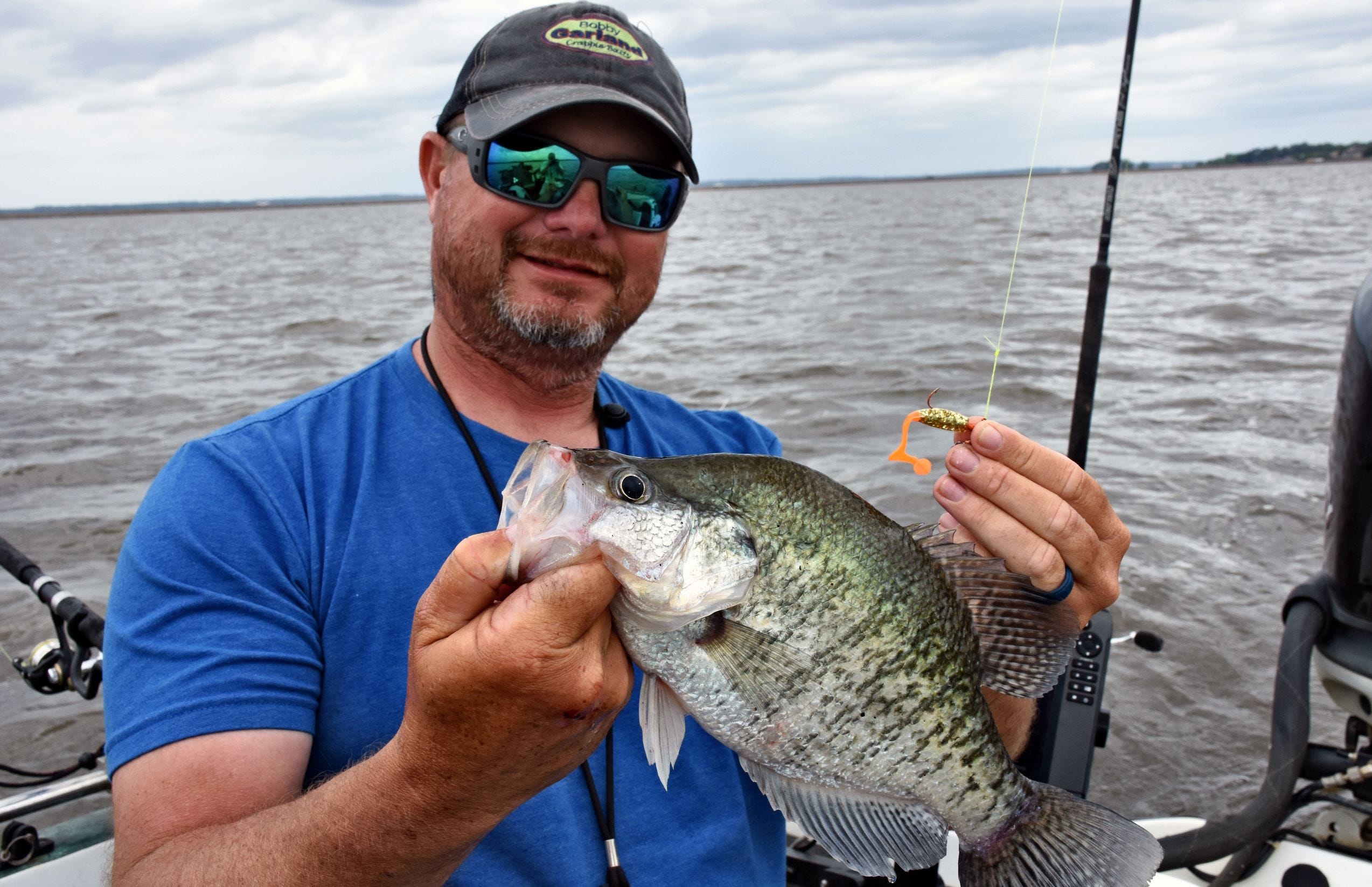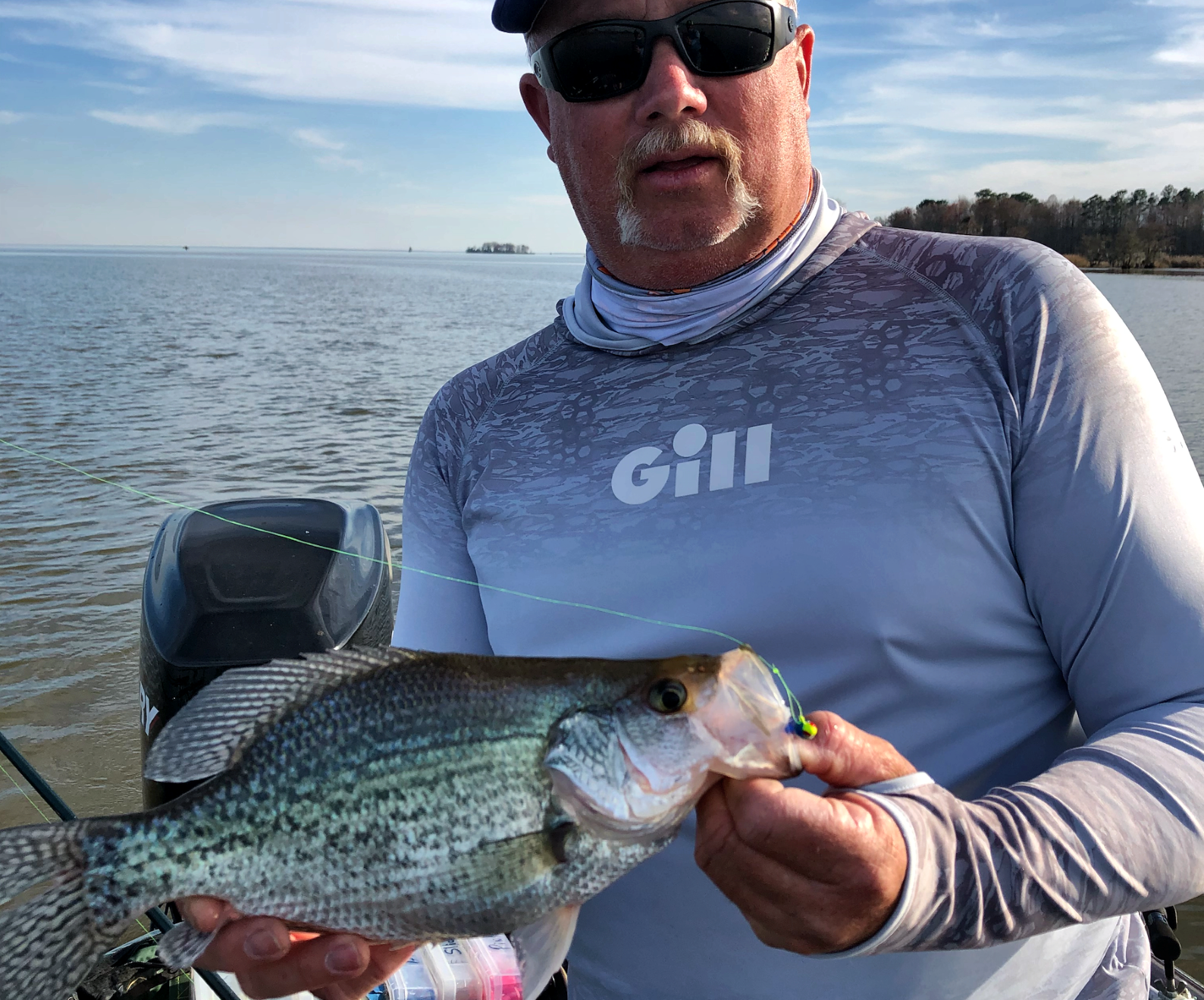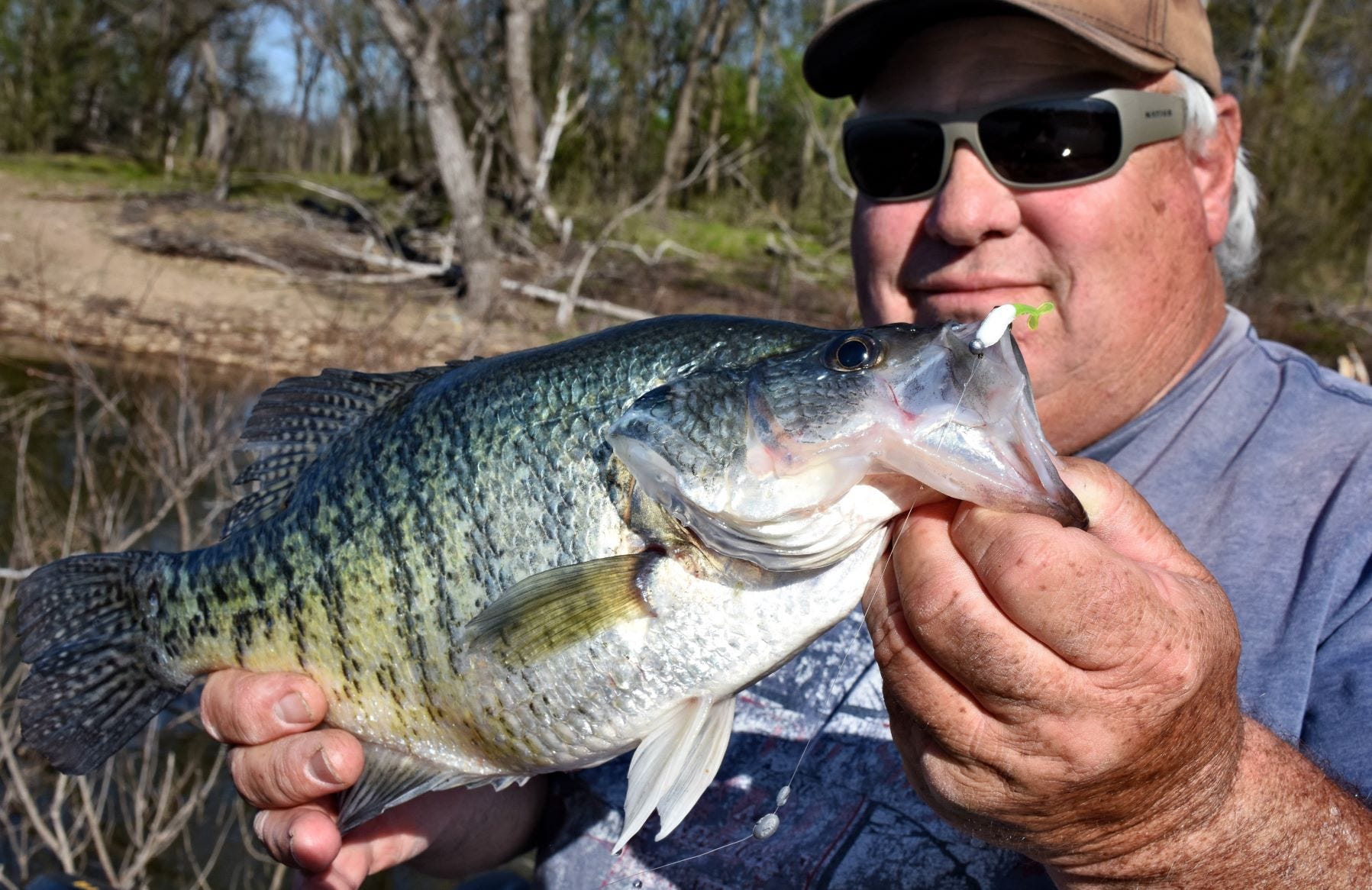- Apr 15, 2022
5 Ways to Catch Spring Crappie
Learn how five expert crappie anglers are catching fish right now and how to catch spring crappie on your home waters.
It seems the weather and crappie spawning behavior team up every spring to drive anglers crazy. That’s certainly happening now, as we hit mid-April.
So, I reached out to five “fish almost every day” anglers from South Carolina to Oklahoma for real time reports on what the crappie are doing and how each angler is catching fish. You’ll see how varied the approaches can be for catching the same black and white crappie that we all pursue in our favorite spots.
Perhaps, 2022 is the year for you to try something new. You’ll never go wrong in borrowing knowledge and tactics from any of these five crappie experts.
Brad Chappell


Mississippi Crappie Guide
Ross Barnett Reservoir, Mississippi
Spawn Report & Current Approach
Brad Chappell, host of the Crappie Connection podcast, believes the spawn is behind a couple of weeks and blames a series of recent cold fronts.
“We had a 10-degree surface temp drop in a matter of hours a few days ago. It’s been a roller coaster ride of ups and downs since then,” Chappell said.
Chappell believes the tardiness will extend the spawning period. He noted the lake’s typical spawn window is 4-6 weeks, but projects this year’s will be more like 8-10.
“Day in and day out during the spawning period and right up until early summer, I’m long-line trolling. It’s a technique that helps me find and stay on crappie when they’re really scattered.”
Long lining is the pulling of crappie jigs behind a boat being moved steadily along by an electric trolling motor. Chappell is one of the best at the technique. His refined system involves multiple rods and state-of-the-art electronics, but he says anyone can take his lessons learned and use the simplest trolling basics to have crappie-catching success.
Chappell trolls with two jigs rigged 36 inches apart. On top is the lighter size, a 1/16-ounce; at the end of the line is a 1/8-ounce. He rigs Bobby Garland Stroll’Rs on both jigheads.
Before, during and after the spawn, he’s doing the same thing: long-line trolling in river and creek channels. He’s found that channels hold the largest volume of crappie and often at the same depths.
Pulling his tandem rig at 1.2 MPH with 100 feet of line out will run baits 10 to 12 feet deep, which is a proven depth for Chappell from spring to summer.
He focuses mostly on channels from the mouths of creeks to about halfway back. “There are waves of crappie moving in and out during the spawn, so I’m spending most of my time where there’s a constant flow of crappie staging, moving in and then moving back out to. When I run across ‘hot spots’ I drill down even tighter.”
His rule of thumb on sunny days is to go with bright colors and glitter, such as Vegas, Horsefly, Outlaw Special and Storm Warning.
For dark-skied days, Chappell goes darker colors. Top choices are Purple Passion, Pumpkinseed/Pearl Chartreuse, Meteor Shower and Junebug/Pearl Chartreuse.
He’ll also run some natural shad colors, such as Glacier, Threadfin Shad and Monkey Milk.
Bait Details
The Stroll’R is 2.5 inches long, with a solid body and big-thumping action tail. Chappell was responsible for the oversized swim tail, telling designers, “It must demand attention.” Chappell and other long liners love the Stroll’R for that reason.
Top Tip
“I let the fish tell me what they want. With every bite or fish caught, I’m paying attention to which lure color it came on, and at what depth and the positioning in relation to channel edges. I’m constantly fine tuning my approach.”
Jeff Lowdermilk


Avid Crappie Angler/Tournament Competitor
Lake Hartwell, Georgia/South Carolina
Spawn Report & Current Approach
“It’s running later this year. We had a snow not too long ago and some frosty nights since, so our water temps are behind. Crappie are staging and are in the right spots to move on in, but not quite yet. We’re still mostly in a pre-spawn condition, with the fish scattered.
“We’ve been dock shooting, and that’s rather typical for how we fish Hartwell this time of year. Docks are great staging areas before crappie move to the banks to spawn, which often is right behind the docks.”
Dock shooting is a technique in which the angler uses his rod and reel much like an archer uses a bow and arrow. A single crappie jig is held in one hand and then is used to draw the line back to dramatically flex the rod’s tip section. Upon release, the jig skips underneath docks, boat lifts, etc., in to covered spots where other techniques can’t reach.
“Our best success has been on docks around secondary points back in the creeks. The best ones usually have some brush. The combination of shade and cover provide a comfortable hideout for staging fish, and then house them again when they move back out.
Lowdermilk prefers to shoot a 1/32-ounce jighead fitted with a Bobby Garland Baby Shad or Baby Shad Swim’R.
“Sometimes the Swim’R tail makes a difference in triggering strikes, and other times the Baby Shad’s straight tail gets the nod. Both skip well and are producing catches right now.”
Lowdermilk spends a lot of time on Hartwell, so he has history of what bait colors work best for him. His usual go-to colors in spring include Green Banana, Outlaw Special, Butter Belly and Blue Ice.
Bait Details
The Bobby Garland Baby Shad is a 2-inch minnow-shaped bait with a long, flexible tail. The 2.25-inch Baby Shad Swim’R offers the same profile but has a jointed body and a swim-foot-tipped tail. Both versions afford technique versatility, from dock shooting to jigging.
Top Tip
“Often, your best docks are the ones with lots of overhead coverings but the smallest and tightest openings for getting a jig underneath. That means you need accuracy and you get that through practice. Dock shooting is fun, try it.
(Note: Bobby Garland makes a Dock Shooting Pull Tab to help anglers with the technique.)
Jim Dant


Avid Crappie Angler/ Tournament Competitor
Carlyle Lake, Illinois
Spawn Report & Current Approach
“It’s still early for us. Our dogwoods haven’t bloomed yet. You know the saying that when dogwoods bloom the crappie are on the banks, right? Females are still out, but males are starting to move in. When the spawn happens, it can do so quickly. We’re ready for it.”
“Carlyle has thousands of Christmas trees along the banks in 6 to 10 feet of water in Allen Branch Creek, thanks to an annual habitat improvement program all over the lake. I love to pitch a bobber to these trees, and then get in tighter and vertically fish a jig right in the middle. This lake is full of crappie, and this year is setting up to be a really good one for catching the species.”
Dant says the bobber approach is aimed at catching black crappie, which tends to position higher in the cover. He sets his bobber at one half of the depth of water he’s fishing.
After working an area with the bobber rig, he moves in and vertically jigs the brush, probing all the way to the bottom.
His jig choice is a Crappie Pro Mo’ Glo 1/16-ounce jighead, usually in chartreuse or orange, rigged with a Bobby Garland 2- or 3-inch Slab Slay’R (says he likes their “wiggly” tails). His favorite lure colors are Lights Out, Licorice Chartreuse Pearl and Outlaw Special.
Bait Details
The Bobby Garland Slab Slay’R is a round, solid body bait with a cupped and pointed, highly flexible tail. It comes in 2-inch and 3-inch sizes and a variety of colors. The bait’s “wiggly” tail makes the series a favorite among jig fishermen.
Top Tip
“You don’t have to have a boat. Carlyle has a lot of riprap that can be accessed by foot. To fish the riprap, cast and retrieve a Bobby Garland Stroll’R parallel to the shoreline about 3 feet out during the spawn.”
Steve Danna


Avid Crappie Angler
Lake D’Arbonne, Louisiana
Spawn Report & Current Approach
“Our spawn is on, and we’ll have waves of fish moving in and out for a while. Some fish are staging, and we also have males in the trees doing their guarding.” It’s a good time for catching big numbers in shallow water, he noted.
“For the 52 years I’ve fished this lake, it’s always been about the green cypress trees for me,” Danna said. “Right now, I’m targeting the ones in 2 to 6 feet of water and not really thinking too much about tree location. They can be along a bank, in a pocket or cove … and even a single tree on a high spot will hold fish. Crappie are on ‘em now and will be all the way up until early June.”
Danna often uses his own hand-tied 1/32-ounce jig or a Bobby Garland 3-inch Slab Slay’R. For the Garland bait, it’s usually rigged on a 1/8-ounce for the shallower approach. And since D’Arbonne “always seems to be off-colored,” he goes with his “dirty-water colors” of Pumpkinseed/Pearl Chartreuse, Horsefly, Bluegrass, Black/Hot Pink and Junebug/Pearl Chartreuse.
He stays off a ways and pitches to the cover, thoroughly working the entire tree. Danna has designed a B’n’M jig pole specifically for this technique. His signature series Tree Thumper comes in 10-foot and 11-foot models.
Bait Details
The Bobby Garland 3-inch Slab Slay’R can be rigged with its cupped tail facing up or down. Cup orientation does influence action. With cup up, the tail is stiffer and serves more of a gliding action. Cup down, the tail is more flexible and vibrates enticingly when vertically jigged.
Top Tip
“A cypress tree’s root structure is what counts for crappie. If you see the tree’s longest limb coming out 5 feet, then know that’s how far the roots will come out, too. Fish the tree’s entire root structure.”
Gary Rowe


Avid Crappie Angler
Fort Gibson Lake, Oklahoma
Spawn Report & Current Approach
“It’s not happening yet, but we’re close, assuming we don’t get blown out by heavy spring rains. But fishing is good now, and I’m catching my better fish – males and females – in brush/wood cover in 10 to 15 feet of water. Lots of little fish are still hanging out deeper off the break lines.”
“Many still don’t believe me until I have them fishing right alongside me, but my catches are coming 10:1 on the Bobby Garland Itty Bit Slab Hunt’R fished as a single jig. I’ve intentionally tried my usual producers in comparison, including the 2” Baby Shad, but even LiveScope shows the majority of reactions are directed toward this little bait. I’m convinced the Itty Bit is representing a size of whatever they’re feeding on most right now.”
Rowe rigs the Itty Bit Slab Hunt’R on a Bobby Garland 1/48-ounce Itty Bits jighead and crimps a 1/16-ounce (or size #7) split shot onto 6-pound test line about 12 inches above his jig. His best presentation has been vertical jigging, starting first high in the cover and then lowering and stopping at different levels. As for lure movement, he says the fish want little or none.
“Hold it still, that little tail will be moving on its own. And don’t think this tiny bait is catching little fish. Already this year I’ve had five over 2 pounds and several more pushing that mark, with all but one coming on the Itty Bit.”
Rowe’s most productive colors have been Bone White/Chartreuse, Lights Out and Bright White.
When asked at what point he’ll go big again, he answered, “I probably won’t.”
“Once the spawn is over and we’re then into the summer months, this little bait matches the summer hatch as well as anything, and it just keeps catching them.”
Bait Details
The Bobby Garland 1.25-inch Itty Bit Slab Hunt’R is minnow-shaped, with a unique two-lobed swim tail. Its profile is larger than most other baits of comparable length. The ribbed solid body creates vibration when contacting limbs and such.
Top Tip
“I’m a believer that you can return to the same brush pile again on the same day. Let it rest at least 30 minutes to an hour, and then return to pull a few more from it. I’ve done it too many times to think otherwise.”



